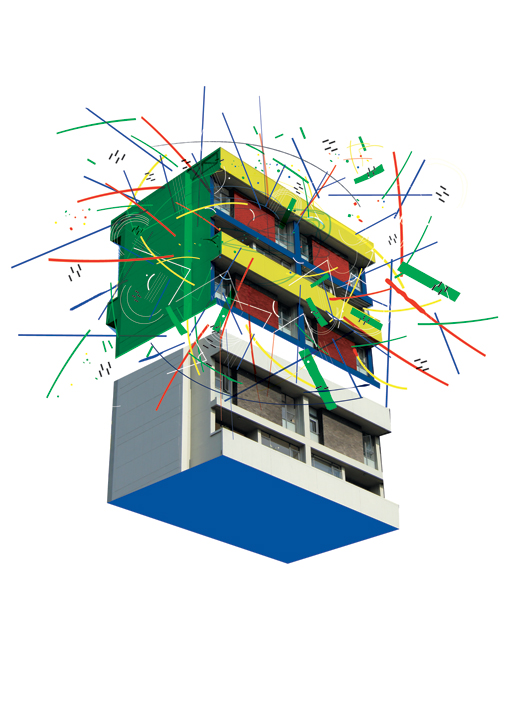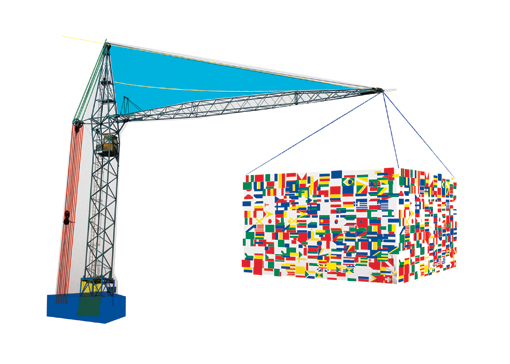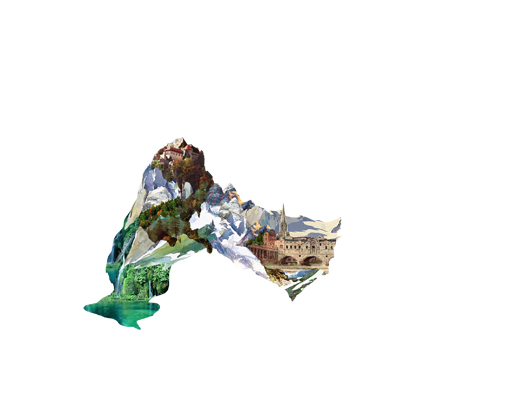Cidade Maravilhosa

text Maria Azzurra Rossi illustrations Raquel Figueira
There are places in the world that can destroy your orientation with each step, others that can wear a mask or hide their real identity, some others that exactly reflect the ideal structure of a city and its propagation’s sound wave: city center, rich neighborhoods, working class districts, suburbs.
There is only one point of coordinates in the whole world that inverts the geographycal reality of wealth/poverty, a place where poor people have always looked at rich people from above from above, a city that as a beautiful woman with her sinuous curves attracts the eyes of the admirers from all over the world.
22°54′30″S 43°11′47″W / 22.90833°S 43.19639°W.
Rio De Janeiro.
Brazil decided to try its luck towards a radical change: FIFA World Cup and Olympic Games (full optional pack). What will be of its security problems, of the curfews and roadblocks?
Who’s going to take care of its future and its inhabitants’ thoughts?
Those very inhabitants that shaped Rio’s landscape and led her first to be called “The Wonderful City” and then to became the first city recognized as a Unesco World Heritage Site under the category “cultural landscape”, now the same people are pervaded with the fear of it becoming one of the first “disposable” model cities.
Rio means colors, music, dynamism, samba, creativity and activities everywhere, bursting nature and cultural mix. But the Carioca city does not just give birth to good feelings, also to bitterness, to an infinite number of lives that everyday survive inside the favelas, that feels to be at the margin of society although living in it’s center.
The favelas during the last years have gladly opened their doors to the city, people frequently gather there to dance a samba, maybe even find themselves queuing to get in or to buy a drink. It’s a good sign of security and trust for the community and, why not, also a profit for the moradores. But at the same time it’s sad to think that nowaday favelas have become touristic and pilgrimage sites.
What is the real attraction in walking between open-air pipes, houses that are dilapidated on the outside and tecnological on the inside, between the children that on saturday are running to the feast in the main square?
What unspeakable taste for adventure can there be in the fear of a meeting with the bosses and the bodies destroyed by crack, glue and the hope to go out in the evening in search of someone to snatch, steal or to simply find easy-money?
The common idea of a community inside the community doesn’t have to blur its evolution. During the last years Rio has drawn the attention and interest of the investors, hungry for lands, unaware of the real identity of the city, blinded by their desire of richness – build, build, expropriate, show cariocas affective restorations (Maracanà stadium, sambodrome), clean, clean, learn the illusionist’s secrets. And it really seems that Houdini has blurted everything out. The investors’ vision is changing the skyline, the visual landscape has to be preserved. The list of changes, of the involved areas and the on-going projects tend to infinity, especially if read in a temporal way: the olympic park and villa in Barra de Tijuca, the revitalization of port area “Porto Maravilha”, the Transcarioca, the waterfront, the cable car of the Morro da Providencia, museums of everything: Museo de Arte do Rio (Bernardes + Jacobsen), Museum of Tomorrow (Calatrava), Museum of Image and Sound (Diller + Scofidio), Città della Musica (Portzamparc – in very slow progress) and, dulcis in fundo, a posthumous work of Niemeyer, the Tower for the Fundaçao Getùlio Vargas.
Radical changes seem to be the engine of what’s going on in Rio de Janeiro, but is it not that all this entropy conceals the stronger actions that are taking place within the favelas?
Yes, of course, the government doesn’t hide, even promotes, the Morar Carioca initiative, nor does the UPP (Pacifying Police Unit) but as documented by “Dominio Publico” between what is said and what is happening, there are always two versions: that of who does the action and the other who suffers it.
For the Brazilian government, the prefecture of Rio and the national/international investors (see Eike Batista, Coca-Cola) everything is going great. The UPP access the favelas, those that have been assigned for the World Cup and the Olympics and, with the best intentions, talks to people, it tries to make them understand that they are there to fix their houses and to solve their life’s conditions. It offers them money to move to other spaces and eats bite by bite precious square meters in some of the most beautiful areas of the city.
The Morar Carioca projects for 215 of the almost 600 favelas are ready, the architects have spoken: tree-lined avenues, bigger streets, social and health services, squares and colors. The workers, engineers, carpenters have taken the field.
For the inhabitants, the neighborhood associations, some researchers, things are not going well at all. The pacific UPP is armed, actions at the Morro da Providencia, shootings and innocents’ deaths make the headlines, as do the attemps to clean the favelas from traffickers and occupiers of the territory. During the construction of the teleferico number signs rained down on houses to indicate a ownership of the prefecture and someone received 400 reais to leave elsewhere, so as to not be subjected to the forced eviction of the entire family.
Although many moradores have seen their safety, hygiene and territory improve, their thoughts aren’t diverted by what could be the interests of those who would like to have a house with a view on the beach, for those who count on the ignorance of those that don’t recognize the healthiness of the place they live, for those who carried bags and bags of cement on their backs to build a roof to sleep under.
The simple and linear dialogue between the two contenders could sound something like this: “It’s not our problem, we don’t have to give you a house!” “Right, you can’t give me a house, but you can take mine and throw me out in the street!”.
Surely they don’t want to transform each favela in Rio in the incarnation of Christopher Nolan’s moated Gotham City just to regain the territory? Years ago they built big walls such walls that even medievable belts would have envied, they cut the morros with cement and now, suddenly the remorse, shoot down the borders, take the houses and move the inhabitants. Who’s inside and won’t leave, will have to protect their life; who moves out, will live but will have to count on the struggle of those that stay.
The UPP results are a great achievement, but also include inhabitants that start to think about social cleansing or about the speculation of their efforts; rivers of money that flow from the governments account to the Atlantic ocean just to have a bath with the sharks; cable cars, streets and undergrounds that maybe even cariocas won’t be able to use.
This all started from the first pacifying operation in Santa Marta in 2008 (maybe Michael Jackson was happy), then the armed entrance in Rocinha in November 2011 and the establishment of the UPP last september made the headlines. It was less hard than in other favelas, although a resident said: “The hands that hold the weapons are different, but the iron is still the same. Can’t you see it on the street?”.
All of this is taking place and will continue over time, at least until 2014 – the supposed end of the works.
And meanwhile the population of the occupied favelas’ map is increasing: Rocinha, Cantagalo, Tabajaras, Santa Marta, Mangueira, Vidigal, Cidade de Deus, Batam, Providençia, Salguiero, Sao Joao, Complexo do Alemao, Turano, Formiga…
But in ten years time, will, Rio de Janeiro still be the Wonderful City we all know or will that sublime feeling be transformed into something totally different?
Tom Jobim pondered: “Brazil is not for beginners” but maybe this is now changing.
(many of these informations have been collected with the help of arch.Elena Geppetti, currently living in Rio de Janeiro, from the docu about favelas/olympics - Dominio Publico, from the Jornal Oglobo, The Post International, ilSole24ore, from the prefecture and the Cidade Olimpica websites)

Esistono luoghi nel mondo capaci di strapparti l’orientamento ad ogni passo, altri in grado di vestire una maschera e celare così la loro vera identità, altri ancora che rispecchiano esattamente l’ideale di struttura di una città e la sua onda sonora di propagazione: centro storico, quartieri ricchi, popolari, periferia. C’è poi un solo incrocio di coordinate in tutto il mondo che inverte la realtà geografica del binomio ricchezza/povertà, un luogo in cui i poveri guardano da sempre i ricchi dall’alto, una città che come una bellissima donna dalle curve sinuose attira a sé gli occhi degli ammiratori da tutto il mondo.
22°54′30″S 43°11′47″W / 22.90833°S 43.19639°W.
Rio De Janeiro.
Il Brasile ha deciso di sfidare la sorte verso il suo radicale cambiamento: Mondiali di Calcio e Olimpiadi (pacchetto completo). Cosa ne sarà dei suoi problemi di sicurezza, dei coprifuoco e i posti di blocco? Chi si prenderà cura del suo futuro e dei pensieri dei suoi abitanti?
Proprio quegli abitanti che modellando il paesaggio di Rio hanno fatto sì che prima fosse denominata “La Città Meravigliosa” e poi che diventasse la prima città Patrimonio Mondiale dell’Unesco per il paesaggio culturale urbano, ora sono invasi dalla paura di vedere uno dei primi modelli di città “usa e getta”.
Rio significa colori, musica dal vivo, vitalità, samba, creatività e attività in ogni dove, natura prorompente e mix culturale. Ma la città carioca non è soltanto fonte di sentimenti positivi, è anche madre di amarezza, di un numero di vite indefinito che ogni giorno sopravvive nelle favelas, che si sente ai margini della società anche se vive all’esatto centro di essa. Le favelas hanno negli ultimi anni sempre più aperto le porte alla città, è sempre più frequente ritrovarsi lì a ballare un samba, magari anche a fare code per l’ingresso o per un drink. È un segno positivo di sicurezza e fiducia per la comunità e perché no, anche un guadagno per chi ci vive. Ma allo stesso tempo è triste pensare che per molti altri siano diventate luogo di pellegrinaggio ed escursioni guidate per turisti.
Qual è la reale attrattiva nel camminare fra le tubature scoperte, le case diroccate all’esterno e tecnologiche all’interno, fra i bambini che di sabato corrono verso la festa nella piazza centrale?
Quale gusto indicibile d’avventura nasce nel timore di un incontro fortuito con i capi della favela e i corpi distrutti dal crack, dalla colla e dalla speranza di scendere di sera in città per scippare, rubare o semplicemente trovare dei soldi facili?
L’idea delle comunità nella comunità però non deve offuscare la sua evoluzione.
Negli ultimi anni Rio ha visto gli investitori voltare tutti assieme lo sguardo, affamati di terreni, ignari della vera identità della città, annebbiati dalla voglia di ricchezza – costruire, costruire, espropriare, mostrare ai carioca ristrutturazioni affettive (stadio Maracanà, sambodromo), ripulire, imparare i segreti dell’illusionismo. E sembra proprio che Houdini abbia spifferato tutto!
È proprio il loro sguardo che adesso sta modificando lo skyline, quel paesaggio visivo da conservare. L’elenco dei cambiamenti, delle aree interessate e dei progetti in corso tende all’infinito, soprattutto se letto in senso temporale: il parco e la villa olimpica a Barra de Tijuca, la revitalizzazione della zona portuaria “Porto Maravilha”, la Transcarioca, il lungomare, la teleferica del Morro da Providencia, musei di ogni estrazione: Museo de Arte do Rio (Bernardes + Jacobsen), Museum of Tomorrow (Calatrava), Museum of Image and Sound (Diller + Scofidio), Città della Musica (Portzamparc – in corso ma non troppo) e, dulcis in fundo, un’opera postuma di Niemeyer, la Torre per la Fundaçao Getùlio Vargas. I cambiamenti radicali sembrano così essere il motore di tutto ciò che sta succedendo a Rio de Janeiro, ma non sarà che tutta questa entropia celi le azioni più incisive in assoluto che si stanno compiendo all’interno delle favelas? Sì certo, il governo non nasconde, anzi promuove, l’iniziativa Morar Carioca né tanto meno la UPP (Unità di Polizia Pacificatrice) ma c’è chi come “Dominio Publico” documenta che fra ciò che si racconta e ciò che succede ci sono sempre due versioni, quella di chi compie l’azione e quella di chi la subisce. Per il governo brasiliano, la prefettura di Rio e gli investitori nazionali e internazionali (vedi Eike Batista, Coca-Cola) tutto va per il meglio. La UPP accede alle favelas più vicine ai terreni assegnati a Mondiali e Olimpiadi e con gli intenti migliori parla con la popolazione, cerca di farle capire che sono lì per sanare le loro case e risolvere le loro condizioni di vita, offre soldi per spostarsi in altri spazi e rosicchiare piano piano preziosi metri quadrati nelle aree più belle della città.
I progetti di Morar Carioca per 215 delle circa 600 favelas sono all’atto pratico, gli architetti si sono espressi: viali alberati, strade più grandi e curate, servizi sociali e sanitari, piazze e colori. Gli operai, ingegneri, carpentieri sono scesi in campo. Per gli abitanti, i comitati di quartiere, alcuni studiosi tutto non va proprio per il meglio. La UPP pacificatrice è armata, fanno notizia le azioni compiute nel Morro da Providencia, le sparatorie e le morti di innocenti, i tentativi di ripulire la favela dai trafficanti e occuparne il territorio. Durante la costruzione del teleferico sono piovuti segni numerici sulle case come ad indicarne la proprietà della prefettura e qualcuno si è visto offrire 400 reais per vivere altrove, per non subire lo sgombero forzato dell’intera famiglia.
Anche se molti moradores da favelas hanno visto migliorare la loro sicurezza di vita, l’igiene e il proprio territorio, non distolgono il pensiero rivolto agli interessi di chi vorrebbe avere una casa con vista sulle spiagge della baia, a chi punta sull’ignoranza di chi non è in grado di valutare la salubrità del luogo in cui vive, a chi ha portato sulla propria schiena sacchi e sacchi di cemento per avere un tetto sotto al quale dormire.
Il dialogo semplice e lineare fra i due contendenti potrebbe suonare così: “Non è un nostro problema, noi non siamo tenuti a darti una casa!” “Capisco, non potete darmi una casa, ma me la potete togliere e lasciarmi per strada!”.
Mica vorranno trasformare ognuna delle favelas di Rio nell’incarnazione della Gotham City con fossato di Christopher Nolan pur di riprendersi il territorio? Anni fa sono stati erette mura da far invidia alle cinta medioevali, hanno ritagliato i morros con il cemento e adesso, improvvisamente il pentimento, abbattere i confini, entrare nelle case e far spostare gli abitanti. Chi è dentro e non esce, difenderà la propria vita; chi esce fuori, vivrà ma dovrà contare sulla lotta di chi non abbandona. I risultati ottenuti dalla UPP sono un grande traguardo, ma sono anche questi: abitanti che pensano alla pulizia sociale o alla speculazione sulle loro fatiche; soldi a fiumi che si riversano dalle casse dello Stato all’Oceano Atlantico a sguazzare con gli squali; teleferiche, nuovi stadi, strade e metropolitane che forse un giorno nemmeno i carioca potranno sfruttare. Tutto questo è iniziato dalla prima operazione pacificatrice a Santa Marta nel 2008 (ne avrà gioito Michael Jackson), ha poi fatto notizia l’ingresso armato a Rocinha nel novembre 2011 e l’installazione della UPP lo scorso settembre, indolore rispetto ad altre favelas in città, anche se un abitante guardandosi attorno ha dichiarato: “Sono solo le mani che impugnano le armi ad essere diverse, ma i ‘ferri’ sono rimasti. Non li vedi per strada?”. Tutto questo è in atto e continuerà nel tempo, se non altro fino a quel 2014 di presunta fine dei lavori. E intanto la mappa delle favelas sanate si popola sempre più: Rocinha, Cantagalo, Tabajaras, Santa Marta, Mangueira, Vidigal, Cidade de Deus, Batam, Providençia, Salguiero, Sao Joao, Complexo do Alemao, Turano, Formiga…
Ma fra dieci anni Rio de Janeiro sarà ancora quella Cidade Maravilhosa che ora tutti conosciamo o quel sentimento sublime si trasformerà in qualcosa di totalmente contrario?
Tom Jobim meditava: “Il Brasile non è per principianti” ma forse questo sta cambiando.
(Molte di queste informazioni sono state raccolte con l’aiuto dell’arch. Elena Geppetti, attualmente a Rio de Janeiro, dal documentario sul rapporto favelas/olimpiadi – Dominio Publico, dal Jornal Oglobo, dal The Post International, da ilSole24ore, dal sito della prefettura e della Cidade Olimpica).
Related Posts :
Category: Article
Views: 3034 Likes: 1
Tags: brasile , brazil , cityvision mag , Maria Azzurra Rossi , Raquel Figueira , rio , rio cityvision competition , rio de janeiro
Comments:
Info:
Info:
Title: Cidade Maravilhosa
Time: 8 marzo 2013
Category: Article
Views: 3034 Likes: 1
Tags: brasile , brazil , cityvision mag , Maria Azzurra Rossi , Raquel Figueira , rio , rio cityvision competition , rio de janeiro






